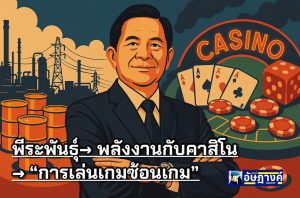
“ไทยต้องใช้อ่อนต้านแข็งในบริบทของภูมิรัฐศาสตร์”
โดย อัษฎางค์ ยมนาค
ผมเชื่อว่า ในโลกยุคปัจจุบันสงครามการค้าปัจจุบันไทยเราต้องการผู้นำอย่างรัชกาลที่ 5 ที่ใช้ความสามารถทางการทูตรบกับมหาอำนาจ ซึ่งทำให้ไทยเป็นหนึ่งไม่กี่ประเทศในโลกที่รอดพ้นภัยจากสงคราม การล่าอาณานิคมและอิทธิพลของชาติมหาอำนาจ
ยุคสงครามการค้าในปัจจุบันก็เช่นกัน ผู้นำที่เก่งการทูตและการค้าระหว่างประเทศของเราอยู่ที่ไหน
_______________________________________________
พระปรีชาสามารถด้านการทูตของรัชกาลที่ 5 กับเกมอำนาจในสุวรรณภูมิ: จากอดีตสู่ปัจจุบัน
การทูตเชิงยุทธศาสตร์ท่ามกลางแรงกดดันจักรวรรดินิยม
ในช่วงปลายคริสต์ศตวรรษที่ 19 สยามต้องเผชิญกับแรงกดดันจากมหาอำนาจตะวันตกอย่างรุนแรง โดยมี อังกฤษ คุกคามจากทิศตะวันตกผ่านพม่า และ ฝรั่งเศส จากทิศตะวันออกผ่านญวนและเขมร
แต่แทนที่พระบาทสมเด็จพระจุลจอมเกล้าเจ้าอยู่หัว (รัชกาลที่ 5) จะตอบโต้ด้วยกำลังและการรบ ซึ่งจะมีแต่แพ้กับแพ้อย่างยับเยินเหมือนอย่างที่จีนและพม่าพ่ายแพ้ พระองค์กลับเลือกใช้ ศาสตร์แห่งการทูตแบบคานอำนาจ (Balance of Power) อย่างแยบคายและทันสมัย
พระองค์ทรงเข้าใจว่า การรักษาเอกราชของสยามในโลกที่เต็มไปด้วยเจ้าอาณานิคมนั้น ต้องอาศัยความยืดหยุ่น การเลือกพันธมิตร และการแสดงออกอย่างมีชั้นเชิง
หนึ่งในยุทธศาสตร์ที่น่าทึ่ง คือการต้อนรับ มงกุฎราชกุมารนิโคลัสแห่งรัสเซีย (ผู้ที่ต่อมากลายเป็น ซาร์นิโคลัสที่ 2 – ซาร์องค์สุดท้ายของจักรวรรดิรัสเซีย)
_______________________________________________
การเสด็จเยือนของมกุฎราชกุมารรัสเซีย: เมื่อการทูตกลายเป็นการแสดงที่มีนัยทางยุทธศาสตร์
ในปี พ.ศ. 2434 มกุฎราชกุมารนิโคลัส อเล็กซานโดรวิช ซึ่งต่อมากลายเป็น ซาร์นิโคลัสที่ 2 ได้เสด็จเยือนเอเชียในทัวร์ระดับโลก โดยมีจุดหมายปลายทางอ้อมโลกจากอินเดีย จีน และไปจบญี่ปุ่น ซึ่งทรงถูกลอบสังหารที่ญี่ปุ่น
ในขณะที่สยามไม่ได้อยู่ในแผนการเดินทาง แต่กลับเป็นดินแดนที่สร้างความประทับใจไม่รู้ลืมของมกุฎราชกุมารที่ต่อมาคือจักรพรรดิจักรวรรดิรัสเซีย รวมทั้งทำให้กลายเป็นการสร้างมหามิตรที่ช่วยไทยคานอำนาจและรอดพ้นการตกเป็นอาณานิคมชาติตะวันตกได้สำเร็จ
ด้วยสายพระเนตรอันยาวไกล รัชกาลที่ 5 ทรงทราบข่าวการเสด็จของมกุฎราชกุมารแห่งจักรวรรดิรัสเซีย จึงส่งพระบรมวงศานุวงศ์และทูตไปเจรจาล็อบบี้กับฝ่ายรัสเซีย จนสามารถเปลี่ยนเส้นทางการเมืองระหว่างประเทศให้หันเข้าหาสยาม ได้สำเร็จการแวะครั้งนี้จึงไม่ใช่เรื่องบังเอิญ แต่เป็นผลงานทางการทูตของสยาม
_______________________________________________
บางปะอิน: เวทีการทูตที่แปลงพิธีต้อนรับเป็นเครื่องมือทาง Soft Power : จุดเริ่มของคำว่า “อย่างกับซาส์”
เมื่อราชนาวีรัสเซียล่องเข้ามาในน่านน้ำสยาม มงกุฎราชกุมารแห่งรัสเซียได้รับการต้อนรับอย่างใกล้ชิด
มีต้อนรับอย่างหรูหราในพระราชวังบางปะอิน ซึ่งถูกบูรณะใหม่ให้เป็นเวทีแสดงความงามของสยามที่ผสานตะวันตกและตะวันออกอย่างสง่างาม
การเลี้ยงรับรองครั้งนั้นไม่ใช่เพียงงานต้อนรับระดับพระราชา
แต่คือ การแสดงนโยบายการทูตผ่านพิธีการ รสนิยม และความสามารถในการจัดการ
พระราชวังบางปะอิน ซึ่งเคยเป็นวังฤดูร้อน ถูกเนรมิตใหม่ให้ หรูหรา สะอาด เรียบงามแบบตะวันตกผสมไทย
อาหารจัดเต็ม พิธีการเป๊ะ และข้าราชบริพารทุกคนเตรียมงานชนิด “ถวายชีวิต”
เรื่องเล่าจากคนในยุคนั้นบอกว่า “หรูหราเกินกว่างานไหน ๆ ที่เคยมีในสยาม” จนกำเนิดวลีอมตะ “อย่างกับซาส์”ซึ่งสื่อความหมายถึง ความหรูหราเว่อร์วังแบบสุด ๆ จนเกินคำบรรยาย
ความหมายที่ลึกซึ้งกว่าคำว่า ‘หรู’
แต่สิ่งสำคัญไม่ใช่แค่ความหรูหรา
สิ่งที่ ร.5 ทรงทำคือ “เชื้อเชิญมหาอำนาจอีกฝ่าย” มาเป็นเพื่อนกับสยาม เพื่อถ่วงดุลกับอิทธิพลของอังกฤษและฝรั่งเศสที่พยายามล้อมสยามจากสองด้าน
และรัสเซียในเวลาต่อมาก็แสดงออกชัดเจนว่า “สยามควรเป็นเอกราช ไม่ควรตกเป็นอาณานิคม”
_______________________________________________
อังกฤษและฝรั่งเศส: กังวลแต่ไม่กล้าแทรก
แม้จะไม่มีหลักฐานชัดเจนว่าอังกฤษหรือฝรั่งเศสขัดขวาง
แต่รายงานร่วมสมัยหลายชิ้นบ่งชี้ว่า ทั้งสองมหาอำนาจจับตาเหตุการณ์นี้อย่างใกล้ชิด เพราะเกรงว่ารัสเซียจะกลายเป็นพันธมิตรใหม่ที่ “ปลอดภัย” และ “เป็นมิตร” กับสยามเกินไป
_______________________________________________
การคานอำนาจ: กลยุทธ์ที่มากกว่าการเลือกข้าง
กรณีการเสด็จเยือนของซาร์นิโคลัส คือแบบอย่างของ “การใช้ Soft Power อย่างมีชั้นเชิง”
พระราชพิธี การต้อนรับ ศิลปะและวัฒนธรรม ถูกนำมาใช้แทนกองทัพ เรือรบ หรือสนธิสัญญาบีบบังคับ
เพราะบางครั้ง… โต๊ะอาหารและรอยยิ้มอาจมีอำนาจทางการเมืองมากกว่าปืนใหญ่
_______________________________________________
มหาอำนาจในสุวรรณภูมิ: ยุคล่าอาณานิคม
ในยุคล่าอาณานิคม ดินแดนสุวรรณภูมิกลายเป็นสนามประลองของ 4 มหาอำนาจใหญ่ ได้แก่
• อังกฤษ – นักล่าอาณานิคมทางทะเล ที่ครอบครองเส้นทางการค้าและคมนาคมทางทะเล ด้วยกองทัพเรือ การค้าแบบบังคับ การตั้งอาณานิคมเต็มรูปแบบ จับสยามลงนามในสนธิสัญญาบาวริ่ง บังคับให้สยามเปิดประเทศเพื่อค้าขายกับอังกฤษ
• ฝรั่งเศส – ผู้นำอารยธรรมแบบตะวันตก ซึ่งเข้ายึดครองอินโดจีน ใช้การทูตเชิงรุก การใช้กำลังทหาร ดำเนินนโยบายกดดันให้ไทยเสียดินแดน
• รัสเซีย – ผู้สังเกตการณ์ที่สร้างมิตรกับรัฐเอกราชในเอเชียเพื่อถ่วงดุลอำนาจ ด้วยนโยบายการทูตแบบราชสำนัก การแลกเปลี่ยนวัฒนธรรม
• จีน – มหาอำนาจเก่าที่ยังคงอิทธิพลเชิงวัฒนธรรมและเศรษฐกิจในภูมิภาค ด้วยระบบบรรณาการ อิทธิพลผ่านชุมชนชาวจีนโพ้นทะเล
_______________________________________________
จากเรือปืนสู่ชิป AI: สุวรรณภูมิในศตวรรษที่ 21
ในศตวรรษที่ 21 สุวรรณภูมิได้เปลี่ยนจากสนามล่าอาณานิคม
มาเป็นเวทีของ เกมอำนาจโลกใหม่ที่ใช้เงินทุน เทคโนโลยี และอิทธิพลเชิงวัฒนธรรมเป็นอาวุธจาก 4 ชาติมหาอำนาจใหม่
• สหรัฐ – ทายาทแห่งจักรวรรดิอังกฤษ
ซึ่งมีฐานทัพในฟิลิปปินส์ มีความร่วมมือแน่นแฟ้นกับสิงคโปร์ อินโดนีเซีย เวียดนาม ผลักดันแนวคิดอินโด-แปซิฟิก และพันธมิตร QUAD และใช้นโยบายต่างๆ รวมทั้งการตั้งกำแพงภาษีเพื่อต้านจีนในทะเลจีนใต้
• จีน – อดีตมหาอำนาจทางวัฒนธรรม กลับมาในรูปของผู้ให้ทุน
โดยใช้โครงการ Belt and Road Initiative (BRI) เป็นคู่ค้าหลักของเกือบทุกประเทศในภูมิภาค สร้างโครงสร้างพื้นฐานในลาว กัมพูชา พม่า ขยายอิทธิพลผ่านทุนการศึกษาและสื่อ
• รัสเซีย – จากพันธมิตรทางใจสู่ผู้ส่งออกอาวุธ
เช่น ขายอาวุธให้เวียดนาม อินโดนีเซีย พม่า และวางภาพลักษณ์ “พันธมิตรที่ไม่แทรกแซง” ต่างจากตะวันตก
_______________________________________________
บทสรุป: สยามรอดเพราะรู้จักเล่นเกมโลก — ประเทศเล็กๆ อย่างไทยเราต้องรู้จังหวะ ยืดหยุ่น และวางตัวให้ฉลาด
รัชกาลที่ 5 ทรงเป็นตัวอย่างของผู้นำที่เข้าใจโลก
ไม่หลงใหลในอุดมการณ์ฝ่ายใด แต่รู้จักสร้างพันธมิตรหลากหลายเพื่อรักษาอธิปไตย
และในโลกปัจจุบัน ที่เปลี่ยนจาก “เรือรบ” เป็น “ข้อมูล-เทคโนโลยี-เงินทุน” ประเทศในภูมิภาคนี้ก็ยังคงต้องเล่นเกมคานอำนาจอย่างรู้ทิศทาง เช่นเดียวกับที่รัชกาลที่ 5 เคยทำ
“ความเป็นกลาง” ในโลกยุคใหม่ ไม่ใช่การอยู่นิ่ง แต่คือ “การรู้จักยืนอยู่ตรงไหน” ในวันที่ทุกฝ่ายกำลังเคลื่อนไหว
_______________________________________________
ผมยังคงเชื่อมั่นและยืนยันว่าผู้นำของไทยในยุคปัจจุบันต้องมีคุณลักษณะและคุณสมบัติที่ใกล้เคียงกับในหลวงรัชกาลที่ 5 ที่รบหรือรับมือกับอิทธิพลของมหาอำนาจหลายขั้ว ด้วยความเข้าใจในเรื่องภูมิรัฐศาสตร์ และอย่างผู้ที่มีสามารถทางการทูตระดับเทพ
สงครามการค้าในยุคปัจจุบันไทยต้องใช้อ่อนต้านแข็ง ในบริบทของภูมิรัฐศาสตร์ เราต้องการผู้นำอย่างรัชกาลที่ 5 ที่ใช้ความสามารถทางการทูตรบกับมหาอำนาจ
_______________________________________________
Thailand Must Embrace Strategic Softness in a Geopolitical World
By Eddie Atsadāng Yommanāk
In today’s complex global landscape, I believe that Thailand needs a leader with the vision and diplomatic finesse of King Chulalongkorn (Rama V)—a monarch who once used the art of diplomacy to confront imperial powers, allowing Siam to remain one of the few non-colonized nations during the height of European expansionism.
In today’s era of trade wars, the question remains:
Where is our leader with the skills in diplomacy and international trade that the moment demands?
This article revisits a compelling case study from the late 19th century, where diplomacy—not force—preserved Thailand’s sovereignty, and it remains profoundly relevant in today’s multipolar world.
_______________________________________________
Strategic Diplomacy Under Imperial Duress
In the late 1800s, Siam was under immense pressure from two colonial giants: Britain, encroaching from the west via Burma, and France, expanding from the east through Vietnam and Cambodia.
Unlike other Asian empires—such as China and Burma—that suffered humiliating defeats by Western gunboats, Rama V chose not to engage in futile military resistance. Instead, he embraced a modern, flexible, and deeply strategic approach to foreign policy, grounded in the Balance of Power theory.
He recognized that in a world dominated by colonialism, sovereignty required adaptability, selective alliances, and diplomatic symbolism.
_______________________________________________
When Diplomacy Became Theater: The Tsarevich’s Visit
In 1891, Tsarevich Nicholas Alexandrovich—who would later become Tsar Nicholas II, the last emperor of Russia—embarked on a global tour of Asia. The original itinerary included India, China, and Japan (where he survived an assassination attempt). Siam was not on the map.
However, thanks to Rama V’s sharp geopolitical instincts, Siam turned this oversight into an opportunity.
Upon learning of the Tsarevich’s journey, Rama V discreetly deployed royal envoys and diplomats to lobby the Russian delegation and successfully altered the course of international relations—literally. The Tsarevich agreed to make an unscheduled stop in Bangkok.
This wasn’t a matter of chance—it was a diplomatic masterstroke.
_______________________________________________
Bang Pa-In Palace: Where Soft Power Was Staged
When the Russian imperial navy sailed into Siamese waters, the crown prince was met with a reception of unprecedented grandeur.
The Bang Pa-In Summer Palace, recently renovated, became a theatrical stage that showcased Siamese elegance—a seamless fusion of Eastern aesthetics and Western refinement.
The banquet was meticulous. The ceremony was flawless. Every member of the court prepared as if national survival depended on it.
The opulence of the occasion was so striking that it gave birth to a lasting Thai expression:
“Yàang Gàp Sās” (Like the Tsar)—now used to describe anything lavish or over-the-top.
_______________________________________________
More Than Ceremony: Strategic Messaging Through Hospitality
But this display was not merely about splendor. It was calculated diplomacy.
By inviting a rising European power that had no colonial ambitions in Southeast Asia, Rama V broke the binary of British-French dominance and signaled that Siam had friends elsewhere.
Later, Russia expressed clear support for Siam’s sovereignty, affirming that the kingdom should remain independent and not fall under colonial rule.
_______________________________________________
Britain and France: Alert but Powerless
While no official records show outright objections, several contemporary accounts suggest that both Britain and France were uneasy with Russia’s growing rapport with Siam.
They understood the symbolism: Siam was no longer cornered. It had friends beyond their reach.
_______________________________________________
Balance of Power: More Than Just Choosing Sides
The visit of Tsarevich Nicholas exemplifies how Soft Power can rival hard power.
Royal banquets, cultural rituals, and architectural elegance were deployed instead of treaties, warships, or threats.
In geopolitics, a well-set dining table can sometimes wield more influence than a fleet of battleships.
_______________________________________________
The Great Powers in Suvarnabhumi: Colonial Era Snapshot
During the colonial period, Southeast Asia—or Suvarnabhumi—became the theater of rivalry among four imperial giants:
• Britain: Dominated sea routes with naval might and coercive trade agreements. Forced Siam into the Bowring Treaty and viewed it as a buffer state.
• France: Positioned itself as a civilizing force, using military and diplomatic pressure to seize territories in Indochina, including lands from Siam.
• Russia: A non-colonial observer, cultivating symbolic friendships to counterbalance Western imperialism through royal diplomacy and cultural exchanges.
• China (Qing Dynasty): A waning power still wielding cultural and economic influence through tributary ties and diaspora networks.
_______________________________________________
From Gunboats to AI Chips: Suvarnabhumi in the 21st Century
Today, Suvarnabhumi is no longer a colony-in-waiting. It is a strategic nexus of connectivity, investment, and ideological influence—a digital battlefield for 21st-century powers.
United States – The Modern-Day Britain
• Military bases in the Philippines; security partnerships with Singapore, Vietnam, and Indonesia
• Indo-Pacific Strategy and the QUAD alliance
• Tariffs and geopolitical positioning to counter China
China – From Culture to Capital
• The Belt and Road Initiative (BRI) funds massive infrastructure across Laos, Cambodia, and Myanmar
• China is the top trading partner for nearly all ASEAN states
• Soft power via scholarships, universities, and media expansion
Russia – From Royal Friend to Arms Dealer
• Arms exports to Vietnam, Indonesia, and Myanmar
• Close ties with Myanmar’s military junta
• Markets itself as a non-interventionist alternative to the West
_______________________________________________
Conclusion: Thailand Survived Then, and Can Thrive Now—If It Plays the Game Wisely
King Chulalongkorn remains a timeless example of leadership in geopolitical complexity.
He aligned not with ideology but with strategy, building diverse partnerships to preserve sovereignty.
In today’s world—where warships have become algorithms, and weapons have become information and investment—Southeast Asian nations, including Thailand, must continue playing the Balance of Power game with precision.
Neutrality today isn’t inaction. It is knowing exactly where to stand, when everyone else is moving.
_______________________________________________
I continue to believe that Thailand today needs leaders with the diplomatic genius and geopolitical insight of King Rama V—leaders who understand that survival is not just about strength, but about knowing how to use softness to counter force.
Thailand must embrace soft resistance in a hard world.
In today’s era of trade wars and shifting global power, Thailand must once again embrace the strategy of “soft resistance against hard power.”
We need a leader in the spirit of King Chulalongkorn (Rama V)—a statesman who wielded diplomacy as a weapon against imperial forces, and safeguarded the nation not by war, but by wisdom.



